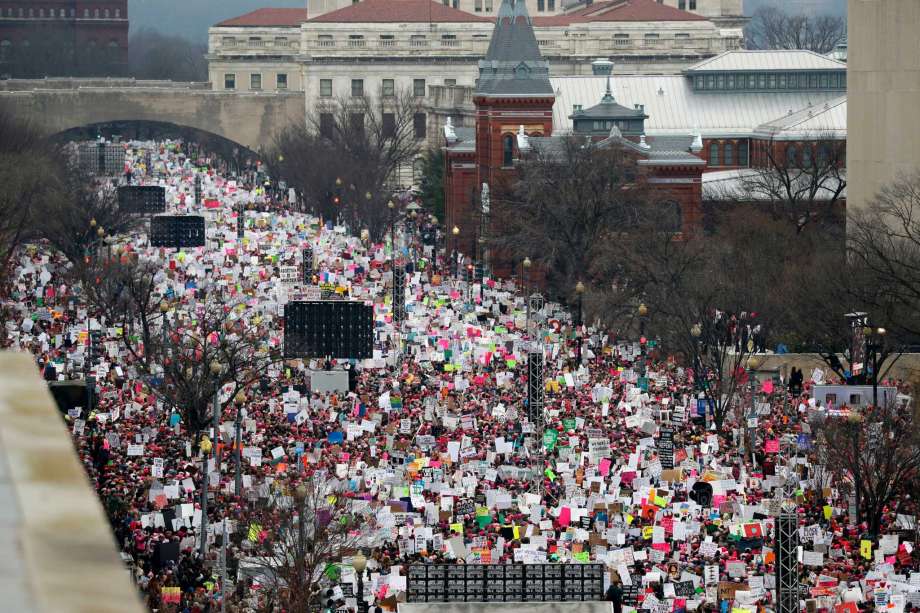
The revolution may not be televised — but it apparently will be tweeted. And Facebooked. And Instagrammed.
Not long after President Donald Trump temporarily barred most people from seven majority-Muslim countries from entering the U.S., social activist Dex Torricke-Barton took to Facebook. “I’m thinking of organizing a rally,” he posted. Within a few hours, more than 1,000 people expressed interest. The resulting protest a week later, in front of San Francisco’s City Hall, drew thousands more.
Torricke-Barton is far from alone. From organizing protests on the fly to raising money for refugee and immigrant rights groups, people have been using social media to fuel the resistance against Trump in ways their organizing predecessors from the 1960s could have hardly imagined.
ROOTS OF PROTEST
In Queens, New York, for instance, a group of 27 women met up to write postcards to their state and local representatives during a “Postcard-Writing Happy Hour” organized through Facebook.
And on Ravelry, the social network for knitters and crocheters, members have been trading advice and knitting patterns for the pink “pussy hats” that emerged as a symbol during the Women’s March on Washington and similar protests elsewhere after Trump’s inauguration.
“This is an incredible project because it’s mixed between digital and physical,” says Jayna Zweiman, one of the founders of the Pussyhat Project. “We harnessed social media for good.”
In 1969, activists planned massive marches around the U.S. to protests the war in Vietnam. The protests, called the Moratorium, drew millions of people around the world. But “it took months, a lot of effort, a national office of the organization to get it off the ground,” says Christopher Huff, a Beacon College professor focused on social movements of the 1960s. “The women’s march was achieved at a much larger scale at a fraction of the time.”
This immediacy is both an asset and a disadvantage. While online networks help people rally quickly around a cause, Huff says, they don’t necessarily help people grasp the “long-term effort” required to sustain a movement.
ONLINE, THEN OFF
In Silicon Valley and across the tech world, Trump’s travel ban created a stir that went well beyond the industry’s usual calls for deregulation and more coding classes for kids. Between aggregating donations, issuing fiery statements, and walking out of work in protest, tech company executives and employees took up the anti-Trump cause at a scale not seen in other industries.
New York-based Meetup, for instance, broke with nearly 15 years of helping people form and join interest groups on a non-partisan basis. “We’re vital plumbing for democracy,” the company wrote in a Medium post this week. “But after Donald Trump’s order to block people on the basis of nationality and religion, a line had been crossed.”
So Meetup held a company-wide “resist-a-thon” — a riff on the hackathons tech companies hold to devise new technologies — to help people get involved in the anti-Trump movement known as “the resistance.” It then unveiled more than 1,000 new “#resist” Meetup groups that people can join for free (it’s normally $15 a month to run a group). As of Wednesday, some 35,000 people had joined the #resist Meetup groups, and scheduled 625 events around the world.
Torricke-Barton, who in earlier incarnations wrote speeches for Facebook CEO Mark Zuckerberg and Alphabet Chairman Eric Schmidt, said he and two sisters of Iranian descent organized their last-minute protest using Facebook groups and Messenger. That’s quite a contrast with Torricke-Barton’s earlier experience protesting violence in Darfur more than a decade ago.
Back then, “lawyers, marketers, communications people would help you get (the protests) off the ground … networks had to be created in advance,” he said. “Now, protests can start without any kind of infrastructure.”
FOLLOW THE MONEY
Shortly after Trump’s order, the venture capitalist Bijan Sabet tweeted a link to the fundraising platform Crowdrise alongside an explanation of his support for the American Civil Liberties Union— and then asked his followers to do the same.
Sabet figured it might take as long as two months to reach his $50,000 goal. It took three days. That weekend, the ACLU raised $24 million, far more than the $4 million it receives in a typical year.
Sabet, whose father is from Iran, says he’s seeing civic involvement “level up,” and that social media is pushing that along. Previously, he said, people would maybe say, “yeah, I’m a bit frustrated, but I don’t have all the information, I don’t know how to get involved.” Now, there’s no excuse.
LITTLE THINGS
The effects of social media aren’t limited to huge efforts.
A week or so after the election, Marisa Frantz, an art director in Cerrillos, New Mexico, created a private Facebook group called “America is Watching.” To join, all people had to do was comment “yes.” If they then posted their zip code in comments, Frantz would send them contact information for their senators and representative, Frantz’s sister-in-law, Sarah Bailey Hogarty, explained in an email.
“Like many of us, I was floundering around feeling terrible and afraid,” said Hogarty, a digital producer for the San Francisco Museum of Modern Art. “I wanted to do something, but I had no idea where to start.”
Hogarty called the group her “foothold to resistance.” Now, the group has more than 1,000 members across the U.S. and organizes weekly “calls to action,” such as contacting senators and representatives about a particular issue determined by a poll of the group.
Groups like this demonstrate how social media has helped “lower the barrier to entry” into social activism, in the words of Tarun Banerjee, a sociology professor at the University of Pittsburgh.
“What social media can do really well is spread awareness,” Banerjee said. “Can people make President Trump back down because of social media? Probably not. But it can shine the light.”
Republished with permission of the Associated Press.



